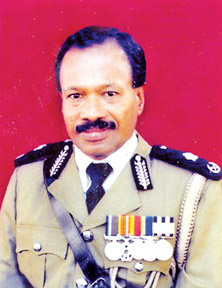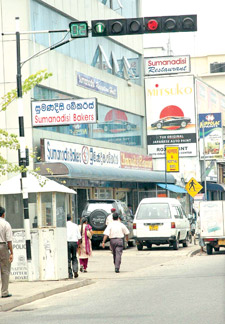|
No parking vehicles on pavements, no jay walking :
Motorists, pedestrians should be civic conscious - WP Traffic Chief
By Ranil WIJAYAPALA
|

DIG Asoka Wijetilleka
|
The development of road stretches, pavements and roundabouts in
Colombo city gives the impression of Colombo emerging as a world class
city very soon. A smooth flow of traffic strictly adhering to road lanes
and pavements for the pedestrians to walk without a hassle are essential
to achieve this.
 |
|
A trafiic police officer
chides the jay walkers |
Pedestrians in Colombo and other major cities in the Western province
now enjoy a hassle free walk along the pavements and roads which were
earlier invaded by thousands of pavement hawkers, after the defence
authorities took action to remove them from the pavements and provide
them with alternative places for their businesses, the city looks
cleaner and more beautiful.
But the haphazard parking practices of motorists has become an
obstacle for the pedestrians to use the pavements as motorists now
invade the pavements vacated by previous pavement hawkers.
Speaking to the Sunday Observer Deputy Inspector General of Police in
charge of Traffic Administration, Road Safety and Western Province
Traffic Operations, Asoka Wijetilleka said that there will be strict
enforcement of the law that prohibits parking on pavements and
pedestrian crossings from February 14.
“Pavements have been designed nicely under the initiative of Defence
Secretary Gotabaya Rajapaksa and roads are being resurfaced in the
metropolis. We can’t afford to allow pavement parking”, the DIG said.
There are good reasons for the traffic Police to strictly enforce
this law, he noted.
“Firstly , if we allow parking on pavements, the newly done up
pavements will be damaged. The second thing is that pavements are meant
for pedestrians. Earlier we had a situation where pavements were used by
pavement hawkers. That problem is non-existent now. If pavements are
blocked by the parking of vehicles it will add another problem,” he
explained.
“When vehicles are parked on the pavements, pedestrians have to walk
the roads. As a result there had been accidents and injuries to
pedestrians caused by some reckless motorists.”
The third reason is that if the pedestrians get onto the roads it
will affect the smooth flow of traffic.
According to DIG Wijetilleka, prior to enforcing this law the traffic
Police had conducted programs to educate motorists about parking habits
and then embarked on imposing fines.
|

Vehicles parked on the pavement |
“But still many motorists breach this rule for their own convenience
and for selfish reasons. They park the vehicles somewhere and leave the
car unattended and work at some places for hours. We are not in a
position to trace them”, he added.
“So now we have embarked on a new program. We will tow vehicles
parked unattended,” he added.
If the vehicle is towed to the nearest Police station for parking
illegally and blocking the road the motorist will have to pay the towing
charges.
“We tow them to the Police station of the respective area. They have
to pay the towing charges for the private companies towing the vehicles
and in addition we will prosecute them in Courts,” the DIG added.
“I have introduced a new system of motor vehicle patrols so that
within a matter of minutes vehicles parked on pavements will be
detected” the DIG added.
But to strictly enforce this law the traffic Police has also taken
the initiative to increase the number of parking areas especially to
facilitate school vans which are usually parked around schools.
“Earlier there was a system where school and staff vans park in some
by lanes. We are not permitting that because we have received complaints
from households that their entrances are being blocked. So we have found
them alternative places for parking at places like Maitland Crescent
where the road is large. The other area is off the carpeted area of
Marine Drive,” the DIG added.
Then the vehicles can come 15 minutes before the school closes and
they can park along the road in single file. They cannot be static there
for more than 10 to 15 minutes.
“So with the introduction of this rule there is some order in picking
up the children. We have to look into the safety of the students as
well. That is why we have given them 10 to 15 minutes and they have to
park in an orderly manner without obstructing the traffic,” he added.
However, they can’t park in two or three lanes as traffic officers
will detect them if they are parked in that manner. “We are deploying
additional traffic Policemen on a regular basis to monitor the
situation,” the DIG said.
“We will also take action against parking attendants if they allow
motorists to park on the pavements and charge money,” the DIG added.
The traffic Police will also enforce the law with regard to the
pedestrians, initially in the Western province.
Traffic Police in the Western Province have conducted educational
programs to educate the public on why they should use the pedestrian
crossing for their own safety and to avoid accidents.
“We have conducted this awareness program for a couple of months and
I think the time has come to prosecute those who do not practise them.
We find, not to a great extent as earlier, but to some extent
pedestrians still crossing the road in a haphazard manner. This is
dangerous,” he added.
“People must not think we are harassing them. We are trying to
discipline them. We are not trying to discipline them for our own
convenience or any other reason but for their own safety,” Wijetilleka
added.
“We are going to deploy additional personnel and do a special
operation for a couple of days and prosecute pedestrians who do not use
pedestrian crossings to cross the roads.”
Imposing spot fines on pedestrians is not possible by current law.
“It is mandatory to produce them in courts and charge them. They will be
notified to come to court,” the DIG said.
Since the new enforcement on February 14, the Western Province
Traffic Police prosecuted 1,379 motorists for parking on pavements and
126 for parking on pedestrian crossings.
“People must be civic conscious. They can’t blame the congestion and
heavy accidents for their mistakes. We are responsible for traffic
management. If you are a motorist you have to follow the lanes”, he
said.
It is important to avoid traffic jams and accidents. Similarly
pedestrians must also be civic minded to follow road rules.
They should use pedestrian crossings to cross the roads instead of
haphazardly crossing the road,” the DIG added.
“We are starting this program in the Western province and with time
implement it in other areas especially in townships because this happens
mostly in the towns,” he added.
|

